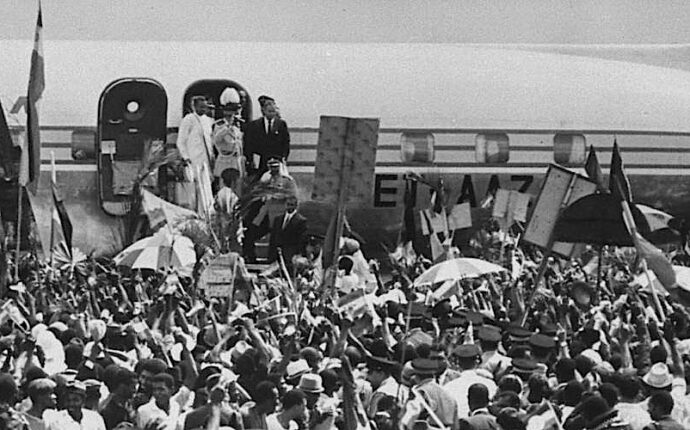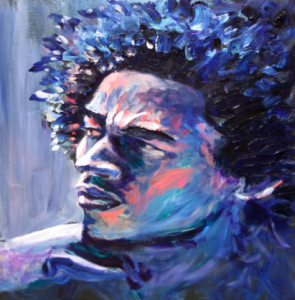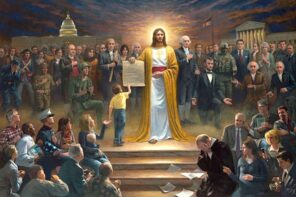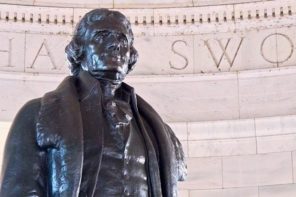As 2015 marks the 50th anniversary of the Selma to Montgomery march, many Americans will understandably and fittingly concentrate their observance of Black History Month on the life and legacy of the Reverend Dr. Martin Luther King, Jr. More than just a Southern or American hero, King has, since that famous march in 1965, become a global icon.
Born one year later in Nottingham, England and raised among many black British of African-Caribbean descent, I knew his story well. And yet, in England as in much of the world, MLK stood among an international array of black activists who were championed for their resistance to racial hatred and its brutal atrocities in all parts of the globe, from urban Britain to colonized Africa; Central America to the western Caribbean.
When I came to the States in the 1990s—to Memphis, no less—I was surprised that the Americans I encountered understood little about the life and legacy of these other heroes, like Ghana’s Kwame Nkrumah, Tanzania’s Julius Nyerere, and even South Africa’s Steve Biko. Having taught African religions in the States for more than twenty years now, I can say that it’s well time they should.
Just as civil rights triumphed over Jim Crow, immigrant patterns in the US began to change radically, complicating not only the traditional white-black binary but the very nature of black America, which now reflects the diversity of the African diaspora(s). One does not have to look too far to find this diversity, embodied as it is not only in the White House family but also crowding the still segregated neighborhoods, churches, and community centers of America’s urban landscape.
Black identity no longer signals, so immediately, a history connected with the slavery and Jim Crow politics of the American South, and those whose roots are deeply embedded in other African diasporas draw our attention to their heroes of anti-colonial resistance and racial justice.
Bob Marley is one of the most misunderstood voices in this discussion. For many Americans the mention of Marley conjures the image of flashing dreadlocks, ganja smoke, and reggae’s hypnotic beat—all of which are pleasant enough. And yet, the politics of consumer capitalism and muckraking media have tainted the remembrance of a potent religious and social activist (as it has also threatened, albeit to a far lesser degree, the memory of MLK). Black Americans of Caribbean lineage, however, recognize this other Bob Marley who, through the Rastafari faith represented in reggae, led Jamaicans in their long postcolonial struggles—“Emancipate yourself from mental slavery / None but ourselves can free our mind.”
In Jamaica, February has been Reggae Month since 2009, and this is in part to commemorate the birthday of the islanders’ most celebrated protest singer and beloved advocate for social change. To mark what would have been his 70th year this February 6th, the University of West Indies in Mona, Kingston, plays host to The Fourth International Reggae Conference, which organizers are describing as a four-day festivity exploring Jah Music’s global ambassador and his varied legacies. From February 11-14, participants will ponder everything from tribute concerts to political monuments; from documentary films to new novels; and from remixed re-releases to ital beverages.
It’ll be all Bob all the time, which is an appropriate tribute to the one who placed the Rastafari faith—and what far more will recognize, reggae—on the world’s cultural map.
Since Marley’s untimely transition in 1981, his children—such as Ky-Mani, Stephen and Ziggy—have established an award-winning musical dynasty, one that has helped to renew their father’s message, and thus prove that Tuff Gong lives on. Even if many Rastafari continue to await the return of His Imperial Majesty Haile Selassie I, Bob Marley has been resurrected, again and again—sometimes with eyebrow-raising results.
Last year the Marley family joined with the market forces that Bob so often bewailed and ventured into the corporate cannabis world, thereby answering a question that academic Roy Augier put to those who attended the inaugural Rastafari Studies Conference in 2010:
When you celebrate Bob Marley, when you celebrate the others, are you not celebrating a Rasta who has made his life in acknowledgment of Babylon? You cannot efface Babylon.
Augier, of course, was right. After all, most of my students, and perhaps many of you, only know Marley and Rasta through consumerist avenues. Still: “As long as there is Babylon, there must be Zion,” observes Emily Raboteau. And as long as there is Zion, there must be Zion singers (Ps. 137:3).
Yes, the many serenaders do include those who identify with the more commercial reggae, perpetuating the distortions of who Marley was. And yet, as we remember his life as a socially-conscious singer, let me draw attention to those who continue that legacy, who yearn for Zion, and who resurrect his particular vision of African excellence in these five songs. Listeners will not simply hear the music’s familiar drum-and-bassline, they will emerge with proficiency in Rastafari and a newfound sense of black history. Bob Marley would be proud.
Adored by Rastafari founders as the fulfilment of Marcus Garvey’s late 1920s prophecy (“Look to Africa for the crowning of a King, for the day of deliverance is near”), Ras Tafari was crowned Emperor of Ethiopia on November 2, 1930. He took the name Haile Selassie, which means “power of the Trinity.” Garveyites in Jamaica, such as Archibald Dunkley and Leonard Howell, grew animated when they heard that “the Conquering Lion of the Tribe of Judah” (Rev 5:5) was among his other titles.
The artist Ancient King is Wendell Francois, a Rasta “chanta” from St. Croix, who burst onto the Caribbean reggae scene in 2002. Released in 2013, “Ethiopie” features Francois’s brusque vocals astride a classic roots reggae pulse, and it chronicles Haile Selassie’s role in the Second Italo-Ethiopian War (1935-1936). Significantly, the song alludes to the Emperor’s stirring speech before the League of Nations on June 30, 1936. Ancient King shadows Bob Marley in this regard since Marley took Selassie’s remarks to the United Nations on October 4, 1963, and created “War,” which he released on 1976’s Rastaman Vibration album.
2. Everton Blender, “Leonard Howell”
Located in the St. Jago Hills high above Jamaica’s old capital, Spanish Town, Pinnacle is the first Rastafari commune, which Leonard Howell (aka The Gong; G. G. Maragh) founded in the 1940s. Howell preached Selassie as the black redeemer, the second coming of Christ, as early as 1933. And in a recent documentary, his biographer sees him as the First Rasta.
Howell provided Rastas with an early statement of beliefs and practices in The Promised Key, which he published in 1935. Although police raids (1941, 1954) eventually crushed Pinnacle, forcing many Rastas to resettle in western Kingston, Howell certainly nurtured the sistren and brethren in their infancy. Blender, who hails from Clarendon Jamaica, triumphs Howell’s achievement in this song from 2001’s Visionary album.
3. JohnStone, “Shashamane Land”
In 1948, Selassie donated land associated with Shashamane, which is located in central Ethiopia, for African expatriates, and the Jamaican government sent a delegation there in 1961. This group spoke to Selassie, who reassured them that he was serious about repatriation for those in the African diaspora. The first settler, Gladstone Robinson, arrived in Shashamane in 1964, and Noel Dyer, the second, and a key spokesperson on John Dollar’s 1992 documentary, arrived in 1965.
His Imperial Majesty reiterated his repatriation invitation during his state visit to Jamaica in April 1966, and numerous Rastafari eventually left the Caribbean and settled in Shashamane to reason, drum, and chant. The best estimates indicate that around 300 Rastas currently reside in Shashamane, which today exemplifies Ethiopia’s commitment to sustainable development, yet many more visit each year from around the globe.
Winner of the 2005 “Song of the Year” at the Washington DC Annual Reggae Music Awards, JohnStone’s song upholds this sacred space’s magnetic influence, relating through rhythmic heft and lyrical dexterity what scholar Erin MacLeod has ably documented in her recent studies—the Rastafari quest for home.
4. Dhextrus, “Coral Garden Rebellion”
Rastafari of the 1940s and 1950s often found themselves at odds with Jamaican society. Hundreds of Rastas marched through Kingston, annexed public property, staged protests, defied social convention, and some broke the law.
For their part, the Jamaican authorities hurridly sought to repress the movement. Rasta reasoning sessions were often broken up by the police, and several collective efforts to repatriate to Africa ended in fighting and failure. On April 11, 1963 violence erupted between Rastas and housing developers in Coral Gardens, Montego Bay, leading to several deaths and numerous arrests, according to Deborah A. Thomas’s and John L. Jackson, Jr’s Bad Friday film.
Released to coincide with the tragedy’s 50th anniversary, Dhextrus’s 2013 dancehall riddim re-narrates this moment in early Rastafari history, and it scores the many Rasta pilgrims who, to this day, travel to Jamaica’s northwest coast to memorialize the event annually.
5. Tarrus Riley, “King Selassie H.I.M.”
100,000 Jamaicans greeted Haile Selassie at the Kingston airport when he made his state visit to the island on April 21, 1966. Rasta elder Mortimer Planno, who influenced the University of West Indies’s sociological Report on the Rastafari movement in 1960, and who eventually taught Marley all he knew, disembarked from the plane with Selassie, and Planno seemed as surprised as the others in attendance when His Imperial Majesty refused to walk down the red carpet rolled out for his arrival.
To this day, Rastas mark the Elect of God’s act of humility with an annual ritual, Grounation Day, and Tarrus Riley’s tuneful homage to this auspicious visit, set over a Nyabinghi drum pattern (three drums working in 4/4 time), underlines Selassie’s mysterious, unparalled divinity.
In the years that followed Selassie’s visit, the Rastas became internationally well known, in part due to Marley’s reggae. And today other musicians, like these five, push history into the present, producing conscious reggae marked by cultural memory as well as spiritual uplift, and they are as much a part of Rastafari’s twenty-first century soundtrack, if not more so, than commercial reggae.






